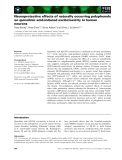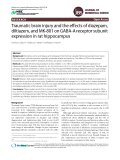
Excitotoxicity
-
Quinolinic acid (QUIN) excitotoxicity is mediated by elevated intracellular Ca 2+ levels, and nitric oxide-mediated oxidative stress, resulting in DNA damage, poly(ADP-ribose) polymerase (PARP) activation, NAD + deple-tion and cell death. We evaluated the effect of a series of polyphenolic compounds [i.e. epigallocatechin gallate (EPCG), catechin hydrate, curcu-min, apigenin, naringenin and gallotannin] with antioxidant properties on QUIN-induced excitotoxicity on primary cultures of human neurons....
 15p
15p  mobifone23
mobifone23
 18-01-2013
18-01-2013
 33
33
 4
4
 Download
Download
-
Excitatory amino acid release and subsequent biochemical cascades following traumatic brain injury (TBI) have been well documented, especially glutamate-related excitotoxicity. The effects of TBI on the essential functions of inhibitory GABA-A receptors, however, are poorly understood. Methods: We used Western blot procedures to test whether in vivo TBI in rat altered the protein expression of hippocampal GABA-A receptor subunits α1, α2, α3, α5, β3, and γ2 at 3 h, 6 h, 24 h, and 7 days post-injuy.
 11p
11p  toshiba23
toshiba23
 18-11-2011
18-11-2011
 52
52
 4
4
 Download
Download
CHỦ ĐỀ BẠN MUỐN TÌM















